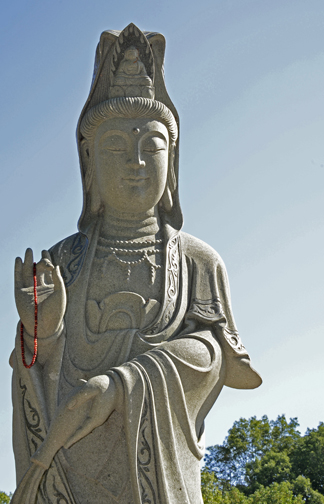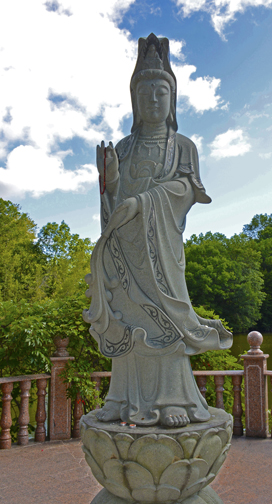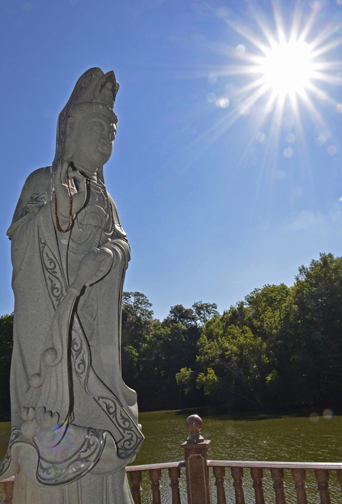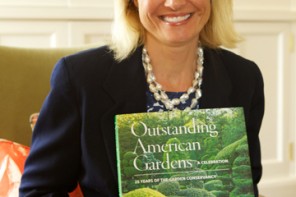Photographs by Bob Rozycki.
Kuan Yin, the Buddhist goddess of mercy and love, is considered by devotees to be the kindest and most forgiving of all the world’s great gods. In the West, she is mainly recognized by art connoisseurs, but in Asia — notably China, Tibet, Japan, Vietnam, Bhutan and Korea — she is believed to be the beloved personification of compassion. Her image has a mysterious, tranquil effect on all believers. Graceful statues of Kuan Yin, in a variety of media, occupy places of honor in their homes as well as within innumerable shrines, temples, grottoes and even public squares.
To me, one of the most thought-provoking aspects of Kuan Yin is that s/he is androgynous — a transgender cosmic being, born male, who evolved into a female. The s/he goddess embodies the noblest characteristics of both female (yin) and male (yang).
Indian sutras relate that Kuan Yin was born in India as a male bodhisattva called Avalokitesvara. He was miraculously manifested from a ray of light that shone from the right eye of the Amitabha Buddha. (Amitabha means “unmeasured splendor” or “boundless light.”) Avalokitesvara was holding a lotus blossom and whispering “Om mani padme hum,” “Hail the jewel in the lotus,” which is now a popular mantra, meaning that the “jewel” dwells in the heart of all beings. The lotus blossom is identified with the aspiring soul, which, like the water lily, born in the mud, rises undefiled through suffering and emotional conflicts and blooms in the light of the divine.
According to the story, Avalokitesvara began life as an ordinary person who followed the path of wisdom. After numerous struggles and incarnations, he reached the supreme goal which all Hindus and Buddhists strive for — nirvana. But on the threshold of total bliss, this noble-hearted soul chose instead to remain on earth to help as a bodhisattva. He exclaimed, “If I am to obtain power to benefit all beings, may I now be endowed with a thousand hands, a thousand eyes.”
During the first century of our era, sutras concerning Avalokitesvara were brought from India to China and later to Tibet by Buddhist pilgrims along the Old Silk Road. The Tibetans considered him to be the earthly representative of Buddha — who lived 600 years before Jesus — and the guardian of the dharma, or sacred doctrine. The 14 Dalai Lamas are believed to be reincarnations of Avalokitesvara.
Chinese Buddhist scholars, however, after lengthy philosophical discussions, held that the qualities of forgiveness and motherly love embodied by the bodhisattva were more feminine than masculine so they reincarnated Avalokitesvara as a woman.
But the sex change was not abracadabra. Rather it happened over a period of 700 years that the god of mercy, Avalokitesvara, evolved into a goddess Kuan Yin, who could give birth and manifest herself in any form in all the six realms of existence — gods, demigods, humans, animals, ghosts and demons — to help all beings attain nirvana. By the seventh century, s/he had become Kuan Shih Yin and Kuan Yin (masculine and feminine), “Mother of 10 million Buddhas” — the concept being that from the feminine qualities of purity, compassion and highest wisdom, Buddhas are born. By the 11th century, the goddess figure had become so popular that the male representative was all but displaced in China.
In some early images, Kuan Yin was depicted as a youth with a slight beard and mustache or as androgynous — embodying the best qualities of both the masculine and the feminine. In later statues, she wears an elegant robe suggesting the flow of life that nurtures all beings. She is often depicted floating on lotus petals. Her beneficence is suggested by various objects she holds — usually a vase of amrita, the dew of immortality, a wish-fulfilling jewel or a willow branch to scatter her compassion.
To the humble she is goddess, mother figure, friend and protector; to the philosophical, the divine force of compassion that pervades the cosmos and holds everything together in harmonious accord.
The characterization of the divine benevolence as an all-giving mother or goddess is one of the highest ideals of Mahayana Buddhism. All carry the same meaning: “The Lord, who is seen, or heard from below,” implying the manifestation of spiritual energy, or the divine perceived by the human self.
Kuan Yin speaks to our spiritual selves. The more we are conscious of our higher nature, the more we feel compassion for others. When the mind and senses are silent, the human being is in harmony with nature, the spirit within blends with the cosmic forces and one becomes blissfully aware that the transcendent powers of the divine are close and the whole cosmos is divinity. This is referred to by mystics as atonement (or “at one ment”); by Buddhists as enlightenment and by Hindus as yoga. The Japanese call it “perfect interfusion.”
The image of Kuan Yin, then, represents the personification of our awakened self-nature. For when self-nature is awakened, and compassion becomes active, we are Kuan Yin — the incarnation of mercy and love.






